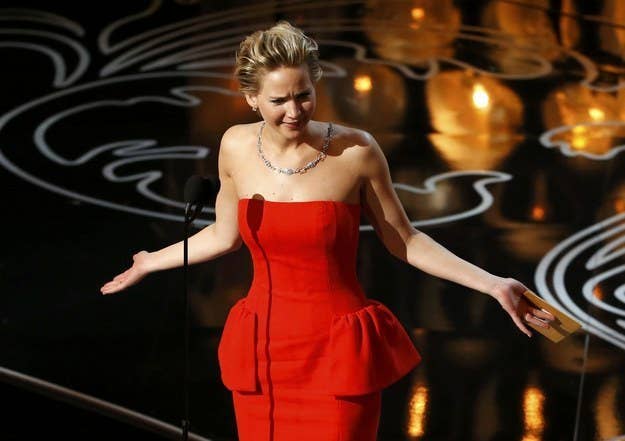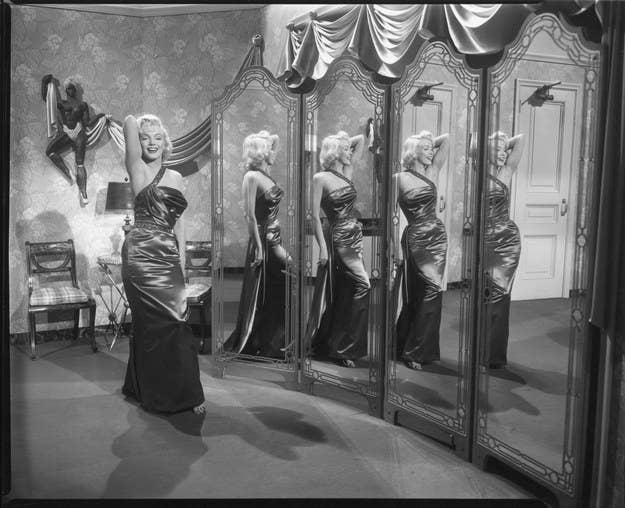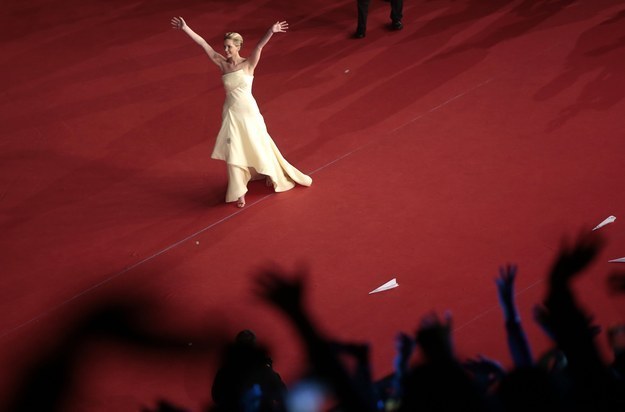
More than 60 years ago, an It girl not dissimilar to Jennifer Lawrence also had highly suggestive and topless photos emerge into the public sphere, just as her career was rocketing from B-player to A-list star. A 23-year-old Marilyn Monroe, desperate for work, posed nude for art photographer Tom Kelley in 1949, receiving $50 for her time.
She made rent, and continued her fledgling career. It wasn’t until 1952, when two of the images from the shoot showed up in a calendar called Golden Dreams, that the photo shoot came back to (potentially) haunt her.
At first, it was mere speculation that the anonymous girl in the pages of the calendar seemed to look strikingly similar to one of Fox’s up-and-coming starlettes. But as it became increasingly clear that it was, in fact, Monroe nude on a bed of red satin, she urged her studio to let her guide her own PR strategy, one brilliant in its simplicity.
Instead of denouncing the images, Monroe took control of the narrative. She’d been hungry and behind on rent, and besides, she had always insisted that the photographer’s wife be in the room. “I’m not ashamed of it,” she told the press. “I’ve done nothing wrong.”

And her comments just kept getting better. “I’ve only autographed a few copies of it, mostly for sick people,” she explained to the The Saturday Evening Post. “On one I wrote, ‘This might not be my best angle.’”
Unlike prior sex scandals, which had each served as a revelation of a hidden self, the photos of a naked Monroe fit with the expectations gleaned from her on-screen performances. (Just four years before, a leading Hollywood star — Ingrid Bergman — had been denounced on the Senate floor as an “instrument of evil” for giving birth out of wedlock, with nary a single nude photo in sight.) Monroe's on-screen persona, or “picture personality,” was defined by sex; it was no surprise when her off-screen activities were as well.
But Monroe’s particular embodiment of sex, and the salience thereof, hinged on an understanding of sex not as prurient, or deviant, but natural — fitting with what came to be known as the “Playboy philosophy,” that sex is only dirty when suppressed. In this way, Monroe reassured the public that posing for those photos wasn’t wrong, or sinful, or something that should end her career — but a young, hungry, ambitious girl understanding her assets and sharing the pleasure of her beautiful body.
Monroe knew that she could fold the potential scandal of the Golden Dreams photos into her existing image, which managed to reconcile the intensely sexual with the overwhelmingly innocent. She giggled, she smiled, she completely neutralized the career-destroying power of those photos. All with a few lines of well-chosen response, calculated to help her audience understand that yes, nude photos might be the site of truth of the Marilyn Monroe image, but that site of truth isn’t cobwebbed and unseemly, but rather the most innocent, natural, and thus unimpeachable form of bliss.
Which brings us back to Jennifer Lawrence. If the potential scandal of the Golden Dreams calendar failed to take hold, it was because a) the images fit within the existing understanding of Monroe’s image, and b) her commentary on the pictures demonstrated her ability to incorporate them into the narrative of her image. The photos of Lawrence are explicit and nude and NSFW, but there’s nothing to suggest anything darker than the sexual appetites of her characters in Silver Linings Playbook and American Hustle.
Those roles, along with Lawrence’s mainstream turn in the Hunger Games trilogy and dozens of interviews, photo shoots, and public appearances, have constructed a star image best described as that of the Cool Girl, a type whose maxim is to be chill and don’t be a downer; act like a dude but look like a supermodel. Joke about butt plugs on national television, go crazy for pizza while looking gorgeous on the red carpet. Fulfill the most pleasing parts of femininity without any of the parts that annoy, perturb, or otherwise highlight just how difficult it actually is to be a “cool girl” in society.
Lawrence’s image is a contradiction, but no less so than Monroe’s own combination of intense sexuality and equally intense innocence. What’s crucial, however, is that Monroe’s image could expand to include the revelation of a set of nude photos — and so, I would argue, can Lawrence’s. Lawrence’s publicist has issued a statement calling the photos “a flagrant violation of privacy,” but even if Lawrence herself says nothing in response, these images, and their invocation of an incredibly hot yet low-key sexuality, are readily incorporated into the preexisting Lawrence image.
No image or activity is de facto scandalous; it only becomes scandalous when it compromises our understanding of how a star, or a political figure, or a teacher or a journalist or a clergyman, should behave. Those understandings are constantly in flux; historically speaking, however, they have been especially ruthless and unfair towards women. At this moment, Lawrence’s Cool Girl image readily expands to accommodate these images, and her response, if there is one, will most likely reproduce the same themes of nonchalance and humor that have defined her image during its rise to cultural dominance.
But just because Lawrence’s image can weather these revelations doesn’t mean that it, or she, should have to. Even as many celebrities make their private lives increasingly available for public consumption via social media (a phenomenon from which Lawrence has notably abstained), no public figure, no matter how well she’s paid, should be denied the basic human right of privacy.
Lawrence offers so much of herself for us to consume; the problem is that once that audience's hunger is in place, it becomes increasingly difficult, especially in the digital age, for anyone — star, publicist, fan — to police and control it. Don’t mistake that for victim-blaming: Just because someone is likable and charismatic and a public figure doesn’t mean that they should, or deserve to be an open target; nevertheless, they become so.
In the less than 24 hours since the leak, I’ve seen very little of the encoded slut-shaming that usually accompanies similar leaks. Hashtags like #LeakForJLaw and #IfMyPhoneWasHacked may be somewhat beside the point, but nonetheless express solidarity instead of shame. And that, coupled with what now seem like the non-events of leaked nudes of Blake Lively and Scarlett Johansson, seems to suggest that the lack of scandal isn’t just about a “fit” with Lawrence’s pre-existing image.
Rather, just as the acceptance of Monroe’s nude photos — and her image as a whole — anticipated the sexual revolution, the acknowledgement that twentysomething females are sexual beings just might predicate a more balanced and less Puritanical understanding of female sexuality.
That’s a hopeful reading, especially in light of what can only be described as a full-scale, if covert, war on women’s rights, especially as pertains to their bodies, over the last five years. Indeed, the person who hacked these photos — not just of Lawrence, but of nearly a dozen other female stars — did so with the knowledge that the naked female celebrity form would, in and of itself, constitute a scandal. That hacker’s understanding isn’t wrong; the media’s treatment of revelations of female sexuality may not be as declamatory as the Senate floor denunciation of Bergman, but it’s equally shadowed with shame.
These photos now exist in the world, and they’re not going away. But as feminists, fans of Lawrence, or just culturally progressive people, we can decide not to align our reactions with the hacker’s intent.
The only way to prevent a market for these type of photos is to stop treating them, and the “secrets” they reveal, as revelatory or scandalous. They don’t tell you anything new about Lawrence. They don’t make you think differently about her. You know why? Because sexuality isn’t, and shouldn’t be, a dirty secret. In her public appearances and interviews, Lawrence has never attempted to make it so. And just because it’s private doesn’t mean it’s dirty — but that’s an algebra that the scandal machine has labored tirelessly to invert, decades before Monroe’s own “dirty” photos came to light.
In the end, it's not Lawrence’s job to correctly “play,” and thus defuse, this potential scandal. Instead, let it be our task to perform the difficult but necessary labor of not being scandalized at all.

